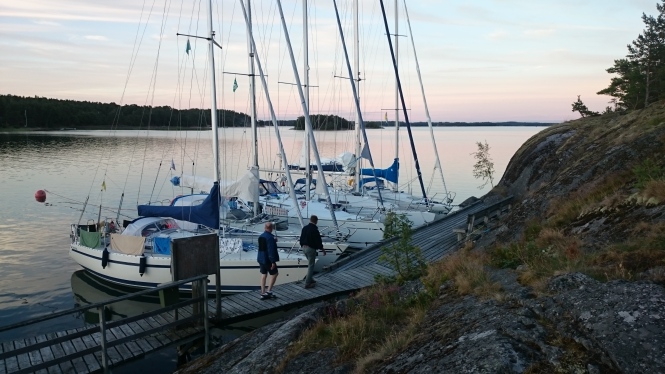Dear blog and readers,
Openness in my teaching practice has not been an issue so far. Courses at our university of applied sciences (TAMK) have been targeted mainly to the degree students, who have access to e.g. our Moodle LMS, where majority of the courses reside. However, the students have been free to use the learning materials to support their learning without any restrictions by the teacher. The students in the degree programs are privileged to access and use our educational offerings for their benefit. It is like sailing on private routes and landfall being allowed for the club members only (Image 1).
 Image 1: Sailing boats in a private harbor (Photo by Matti Karlsson 2019)
Image 1: Sailing boats in a private harbor (Photo by Matti Karlsson 2019)
ONL course topic 2 raised the issue of openness and made me to rethink how to deal with it. Should my courses, learning materials, learning methods, course structures, assignments, etc. be open to anyone? How should I share those and what would be the advantages and disadvantages of doing so?
I think open resources and networking will provide opportunities to create something cool, which is not possible alone. However, networks are difficult or even impossible manage and networking will consume extra resources. It is necessary to discern when it is wise to share and when such behavior is stupid or even illegal.
In this blog post, I will take more philosophical than practical stance to openness. I will use old sociological theories to justify openness, acknowledging that sociology is not one of my core competence areas. Then I will make a short summary, how openness is encouraged in the new learning theories, enabled by the use of technology. Lastly, I take an example from genealogy, which is not my competence area, either, and contrast closed education system with inbreeding.
The Strength of Weak Ties
Last year I participated a course in Tampere University named “Networks in Service Business”, where I read a few articles about networks. Now I will reuse some of my learnings in a different context. In one of the articles, Dr. Granovetter (1973) discusses the strength of dyadic ties and the implications to the macro level of sociological theory. It is an old paper, but still valid thinking.
Weak dyadic ties at micro level offer a means to understand relations between the groups at macro level. Specifically, weak ties provide for a bridge between micro and macro levels, along which micro-level interaction translates into macro-level patterns and again feed back to the micro level. In this blog post I will explain, why I think this is interesting in open learning networks, too.
Let’s call two individuals A and B, and people connected to them, belonging in the set S=C, D, E, … According to the hypothesis presented in the paper, the stronger the tie between A and B, the larger the proportion of individuals in S to whom they both will be tied. This hypothesis is justified with earlier research by using time and similarity arguments, theory of cognitive balance and some direct evidence. For details see Granovetter (1973, p.1362).
The hypothesis applies to micro level or small groups. However, Granovetter (1973, p.1363) extends this thinking to macro level by considering triads with strong, weak or absent ties. To justify his thinking, he presents the concept of a “forbidden triad”. This means an unlikely situation that A is strongly linked to B and C, but B and C are not linked at all. Granovetter claims that there must always be a strong or weak link between B and C in this case.
The importance of the weak ties becomes understandable by using the concept of a bridge, which means the only path connecting two nodes of the network. Based on the above reasoning, a bridge cannot be a strong tie, because otherwise it would not be the only link between any contact of A and any contact of B. Therefore, bridges are always weak ties, but not all weak ties are bridges. In practice, bridges are not always the only links, but they are the shortest and local links. When the distance between the nodes becomes longer, also distortions and costs of the transmission will increase.
Bridges are important for innovation diffusion, because along the bridges innovations or ideas can spread to wider audience. If bridges are non-existent, then there are only isolated islands with strong ties between the members of the group, but no connections between the groups. Therefore, individuals with many weak ties are better in spreading innovation than those with strong ties. This has been shown in several earlier studies (Granovetter 1973, 1367-1369).
At organization level, some communities are able to organize for common goals easily and some are not. Fragmented communities, i.e. those with missing weak ties, cannot easily organize for common goals. This has also to do with the trust in the leaders, which is related to the capacity to predict and affect the leaders’ behavior. Trust requires direct or indirect links, which are non-existent in fragmented communities. The conclusion is that the more local bridges there are in the community and the greater their degree, the more cohesive the community and the more capable of acting in concert. I think we recently got an example of this in Finland during the “corona crisis”, as different authorities could not effectively combine their forces to manage people arriving to the airports.
Differently from earlier sociological research, Granovetter (1973) claims that weak ties lessen the expectations of transivity (if A is related to B and B is related to C, then A is related to C) and enable analysis of inter-group relationships. Personal experience of individuals is closely related with larger scale aspects of social structure. The weak ties to larger communities will widen the individuals’ opportunities and help them to integrate into communities.
Communities of Practice and the role of technology in openness
Learning ecosystem consists of networks of the students, networks of the teachers, networks of information, organizational structures, technological actors and the curriculum. In such an ecosystem, learning becomes a process of co-creation between the actors, rather than the learner producing learning outcomes required by the teacher.
Recent learning theories acknowledge social construction of knowledge as the way of learning in the 21st century. Collaboration is not restricted only to the classroom or study group, but extends to wider communities, especially by using digital technology. The students form “Communities of Practice” around the subject matters. Community of Practice can be described as follows:
“A Community of Practice can evolve naturally because of the members’ common interest in a particular domain or area, or it can be created deliberately with the goal of gaining knowledge related to a specific field. It is through the process of sharing information and experiences with the group that members learn from each other, and have an opportunity to develop personally and professionally (Lave & Wenger 1991). “
Goodyear (2005) states that some of the richest examples of networked learning involve interaction with online materials and with other people. George Siemens (2005) introduces an idea of a new learning theory called connectivism, which he describes as the integration of principles explored by chaos, network, and complexity and self-organization theories. He claims connectivism to be the Learning Theory for the Digital Age.
“Recent learning theories acknowledge social construction of learning (or collaboration) as the way of learning in the 21st century. Collaboration is not restricted only to the classroom or study group, but extends to wider communities, especially by the use of technology. The students, instead of learning alone, form “Communities of Practice” around the subject matters.” Siemens (2005)
According to Granovetter (1973), networks can be described in terms of network density, meaning the number of ties between the individual and his/her friends divided by the possible ones. Different parts of the network may have different densities leading to concepts of “effective network” (dense) and “extended network” (less dense). The individual’s strong ties and non-bridging weak ties form the dense networks and bridges form the less dense one. Earlier research has shown that less dense networks are important sources of information. Weak ties also play an important role in social cohesion on the macro level.
Talking about connectivism, Siemens (2005) acknowledges weak ties as links or bridges that allow short connections between information, thus resembling Granovetter’s thinking. Goodyear, Banks, Hodgson & McConnell (2004) discuss the importance of ICT technology as an enabler of networked learning. According to them, networked learning means that “… ICT is used to promote connections: between one learner and other learners; between learners and tutors; between a learning community and its learning resources.”
Being open in education is like sailing on open seas (Image 2). However, you have to read the navigational chart and the instruments carefully to avoid the underwater rocks.
 Image 2: Sailing on open seas (Photo by Matti Karlsson 2019)
Image 2: Sailing on open seas (Photo by Matti Karlsson 2019)
Learnings from inbreeding
Recently, I have read about using DNA in genealogy research. During the last 20 years the progress with DNA research has been incredible. It is nowadays quite inexpensive to take a test in order to find about your relatives and ancient origins.
In the history, there are instructive examples, how inbreeding will destroy the offspring’s DNA and create severe diseases. Habsburgs royal family are a famous example of inbreeding. At the end, Charles II was so ill that he could not have any children.
“While these diseases are quite rare in the general population, the fact that so many of Charles’ ancestors were related to each other would have increased his chances of inheriting the genes associated with them. Whether Charles did in fact suffer from these specific diseases is still open to interpretation, though it is clear that his physical and mental difficulties prevented him from fathering any heirs to the throne. The Habsburg dynasty in Spain ended when Charles passed away in 1700, a few days shy of his 39th birthday.” (https://blog.23andme.com/ancestry/the-end-of-a-dynasty-how-inbreeding-doomed-the-house-of-habsburg/).
I wonder if there is same kind of danger with inbreeding of education and knowledge, which may happen in too closed educational systems? Therefore, I think it would make sense to make education more open and exchange resources along the bridges with people and organizations, with whom there has not been collaboration before. I think this ONL201 course will serve that purpose quite nicely, in my case at least.
References
23andMe under Ancestry (2009) The End of a Dynasty: How Inbreeding Doomed the House of Habsburg. https://blog.23andme.com/ancestry/the-end-of-a-dynasty-how-inbreeding-doomed-the-house-of-habsburg/
Goodyear P. (2005) Educational Design and Networked Learning: Patterns, Pattern Languages and Design Practice. Australasian Journal of Educational Technology, 21(1), 82-101
Goodyear, Banks, Hodgson & McConnell (2004). Advances in Research on Networked Learning. COMPUTER-SUPPORTED COLLABORATIVE LEARNING. VOL. 4.
Granovetter, M. (1973). The Strength of Weak Ties. American Journal of Sociology, 78(6), 1360-1380.
Lave J., Wenger E. (1991). Situated Learning: Legitimate Peripheral Participation. Cambridge: Cambridge University Press.
Siemens G. (2005). Connectivism: A Learning Theory for the Digital Age. http://www.itdl.org/journal/jan_05/article01.htm